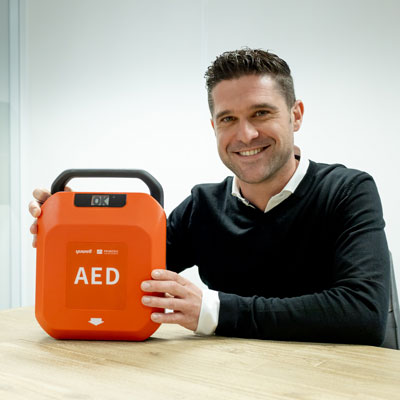Frequently asked questions.
Why is AED maintenance important?
Regular maintenance of your AED is crucial to ensure the device is always ready for use in emergencies. Without timely checks, batteries and electrodes can lose their effectiveness, which may cause the AED to fail when it's needed most. An AED maintenance contract ensures that your device is periodically inspected, tested, and updated by professionals. This not only meets legal requirements but also increases the chances of a successful resuscitation.
How often should an AED be serviced?
The recommendation is to have your AED professionally checked at least once a year. In addition, it’s important to regularly (e.g. monthly) check whether the status indicator is green and whether the electrodes and battery are still within their expiration date. The AED manufacturer may provide specific maintenance intervals and recommendations, so always consult the device manual.
What does an AED Solutions maintenance check include?
Regular maintenance ensures your AED remains reliable. During a service check, we inspect the device for damage, perform functional tests and simulated shocks, read and clear any error codes, replace parts if needed, and update the software. This way, you’re always assured of a properly functioning AED in an emergency.
What is a baseline check?
A baseline check is needed if your AED hasn’t been serviced by AED Solutions before or hasn’t had maintenance for a long time. This inspection helps assess the current condition of your AED and detect any issues. During the check, we thoroughly examine the device, including the status of the battery and electrodes. If needed, outdated parts are replaced immediately so your AED is fully operational again. After the baseline check, you can choose to include your AED in a maintenance contract for regular inspections and optimal performance.
How often should I check an AED?
The recommendation is to have your AED professionally checked at least once a year to ensure it remains reliable in emergency situations. During these checks, we not only inspect the physical condition of the device but also verify the expiration dates of the electrodes and batteries, and perform functional tests to ensure everything is working properly. We also check the software version and carry out updates if needed, as AED reliability can decrease after 8–10 years of use. All of this helps extend the lifespan of your AED and ensures it is always ready for use. With our maintenance contracts, you can choose one, two, or even four check-ups per year, depending on your specific needs.
Is it mandatory to have an AED inspected?
Currently, there is no legal requirement to have an AED inspected, ust as owning an AED is not yet mandatory. However, it is strongly recommended to have the device thoroughly checked and serviced each year. This ensures your AED is always ready for use and remains reliable in emergencies. With a maintenance package, you can schedule regular servicing, which significantly improves the lifespan and effectiveness of the device.
When should I replace AED batteries and electrodes?
Replacing batteries and electrodes is an important part of AED maintenance to ensure the device remains safe and ready for use. Electrodes typically need to be replaced every two to four years, while batteries usually last four to five years, depending on the model and usage. You can replace these parts yourself, but it's wise to consider regular AED maintenance by a specialist. This ensures that all tasks are carried out professionally and that your AED is always in optimal condition. Regular checks and timely replacement of these components are essential for the reliability of your AED in an emergency.
How long does an AED last?
An AED typically lasts between 8 and 10 years, depending on usage and maintenance.





